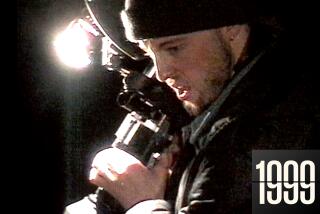The Marketing Wizard Behind the ‘Witch’
The man who is poised to turn the smallest movie of the summer--the super-low-budget thriller “The Blair Witch Project”--into one of the season’s biggest hits was basking in the Santa Monica sunshine last week, a big smile on his face.
John Hegeman and his 11 marketing staffers at Artisan Entertainment had worked for months to build the public’s awareness of their little horror movie, a “mockumentary” that purports to be the discovered footage of three filmmakers who disappeared in the Maryland woods. Lacking the deep pockets of a big studio, Hegeman’s team had forgone expensive network television advertising (until a few days ago), relying instead on an Internet Web site, a comic book and other so-called “guerrilla” marketing tactics to get the word out.
Hegeman was grinning because his tactics are working. The movie grossed $3 million on just 27 screens in its first week; the phenomenon continued over the weekend, when the film grossed another $2 million--a whopping $64,500 per screen--for a total of $5 million.
The “Blair Witch” Web site is racking up 3 million hits a day, with 40 million hits since its creation in April. Tracking shows that many Americans--and particularly teenagers--are more eager to see “Blair Witch” than any other movie. Best of all from Hegeman’s viewpoint, underdog Artisan seems to have the big boys on the run: Last week, two major studios suddenly moved their movies’ release dates from Friday, when “Blair Witch” expands to 800 screens.
Seemingly out of nowhere, “Blair Witch” has become one of the year’s most talked-about films. As moviegoers wait in long lines for tickets, marketers at rival companies are studying Hegeman’s clever campaign, which could change the way Hollywood thinks about publicizing its product.
“When you have a lot of money to spend on TV, no one [at a big studio] asks, ‘What are you doing at the grass-roots level?’ because they want to say, ‘We’re spending $25 million on P and A [publicity and advertising], so don’t worry,’ ” said Hegeman, who so far has spent a mere $1.5 million marketing “Blair Witch,” and who expects to spend no more than $10 million altogether. “There are a lot of other ways to get to people other than throwing money at them.”
This is the gospel according to Hegeman--a fiercely personal ideology born out of his gleeful competitiveness and his long-standing fascination with independent film. He and most of his staff learned the ropes inside big studios (he supervised research, among other things, at MGM and the now-defunct Orion Pictures). But he loves the challenge of selling “specialized” (or art house) films. Meticulous, tireless and blunt-spoken, he never whines about the limited promotional budget at Artisan (which he took a pay cut to join 18 months ago). Instead, he seems to enjoy the constraints, as if they make success even sweeter.
“For me, the independent scene is a much more rewarding experience--figuring out something that other people don’t want to take the time to figure out, but should,” said Hegeman, 36, whose title is a mouthful: executive vice president of worldwide theatrical marketing. “When people say something can’t be done, that in itself is motivation enough to say, ‘Yes, it can.’ ”
Artisan bought “The Blair Witch Project” at this year’s Sundance Film Festival, paying about $1 million for a movie that cost less than $100,000 to make. The brainchild of five filmmakers from Florida, the film bears no resemblance to a slick, Hollywood horror movie. Shot largely on video, with hand-held cameras, it is a jittery, off-kilter experience. At times, the screen goes black, as the movie’s three lead characters--who are supposedly shooting a documentary of themselves searching for a witch--are so terrified that they drop their cameras.
From the get-go, the positive spin on the film--one that many critics have trumpeted since--was that it was wholly original and hugely frightening. The negative spin--one that made acquisitions executives at several other film distribution companies decide not to even bid on it--was that the movie was repetitive, herky-jerky and downright irritating. Artisan’s marketing team had to ensure that the positive view prevailed, and some say Hegeman was uniquely qualified to lead that effort.
“He takes the idiosyncrasies of a film and turns them into incredible virtues,” said John Sloss, a top lawyer in the independent film world who got to know Hegeman during the marketing of Victor Nunez’s indie hit “Ulee’s Gold.”
Filmmaker Darren Aronofsky, whose movie “Pi” made millions more than anyone expected last year with the help of Hegeman’s team, summed up Hegeman this way: “He’s very much the guerrilla marketing guy. By any means necessary, get the word out there.”
What that meant for “Blair Witch” was a multilayered campaign--including a documentary-style special on the Sci-Fi Channel, a Web site (https://www.blairwitch.com) that was updated weekly and an aggressive word-of-mouth campaign--that was designed to build slowly, over more than four months. The idea was to “condition” the audience, he said, making them feel as if they were discovering something new, so that when the film departs from traditional Hollywood formulas, they won’t feel gypped.
Hegeman’s organizing principle: Don’t patronize the consumer, particularly the young consumer.
“Moviegoers in general, no matter how old they are, are pretty smart. They know that some guy in a suit, at a studio, is trying to fool them by making a movie look like what they think kids want,” said Hegeman, who arrived at an interview wearing denim painter’s pants, a black T-shirt and ankle boots and said he felt dressed up (he usually wears shorts to work).
“But there’s a difference between fooling an audience and conditioning an audience. And when you have the time to condition an audience, you have the ability to have them be accepting of your movie, warts and all.”
Knowing When Instinct Trumps the Numbers
The conditioning for “Blair Witch” began on the Internet. Hegeman is a big believer in cyber-marketing, having set up the first promotional Web site for a movie for the 1994 sci-fi film “Stargate.” For certain films--particularly those with futuristic themes or young target audiences--he believes the Web is an excellent way to hook consumers, involving them in a project by offering something different than what they see on TV or in print ads. With “Blair Witch,” his team had plenty to offer: about 16 hours of footage, shot by the filmmakers but not used in the film.
“We turned it into almost weekly programming that helped establish the back story,” Hegeman said of the footage, which was revealed in increments on the Web.
At the same time, Hegeman’s senior vice president of theatrical marketing, Amorette Jones, deployed street teams--young interns who went to dance clubs and coffee houses around the country to ask people what they knew about “Blair Witch.” Jones, a movie marketing veteran who also worked briefly in the music industry, where such tactics are more common, armed her troops with materials that kids would think were cool--a glossy “Blair Witch” dossier, cassettes with one song from the soundtrack, realistic-looking “Missing” posters that seek information about the whereabouts of the film’s three stars.
In addition to promoting the film, the interns sought feedback on how the marketing campaign was being received.
“We sent them out on the streets asking, ‘Hey, guys, are you down with this symbol?’ If they’d said, ‘This is wack,’ we would have gone back to the drawing board,” Jones said, referring to the stick figure that has become the “Blair Witch” icon. “Young people want a dialogue, not a monologue. We were trying to sell a product, but we absolutely were listening.”
Hegeman also used traditional methods, like coming attractions, but even here the campaign was unusual. Three short trailers were revealed in order--one every six weeks over an 18-week period. Each 30-second spot was crafted to build upon the last, with the third timed to be released with “Star Wars: Episode I The Phantom Menace,” when moviegoing would be at its peak. The first was modeled on a trailer Hegeman admired from “The Addams Family” campaign in which the screen stayed black as the famous theme song (with its snapping fingers) played. The “Blair Witch” version: a black screen accompanied by the frightened voice of the movie’s lead character.
“It set it up: the most terrifying part of ‘Blair Witch’ is what you don’t see,” he said.
The second trailer explained the myth of the Blair Witch and established that three filmmakers had gone missing while investigating her. “Do you think the occult had anything to do with it?” someone is heard to say. The third trailer incorporated favorable quotes from critics, which Hegeman thinks will help broaden the audience beyond teenagers.
Hegeman’s team created a mythology around “Blair Witch,” releasing a soundtrack CD even though there’s no music in the film. The CD, “Josh’s Blair Witch Mix,” is said to be copied from a cassette found in one of the disappeared filmmakers’ cars.
Given the complexity of this campaign, it should come as no surprise to learn that Hegeman--the son of an accountant from Yonkers, N.Y.--is a stickler for organization. Admittedly “anal,” he is a relentless list-maker who relies on three highlighters (red, green and yellow) to prioritize his every move. Though no good at math, his attention to detail has earned him a reputation as a brilliant analyst of market research. Moreover, he knows when to ignore the tracking in favor of intuition.
Terry Curtin, Universal Pictures’ executive vice president of publicity, who worked with Hegeman at MGM on campaigns for “Get Shorty,” “Leaving Las Vegas,” “The Birdcage,” “Goldeneye” and “Silence of the Lambs,” says Hegeman was a whiz with numbers, but “was willing to throw them out in favor of the gut every time. He has a really great compass.”
And his enthusiasm for independent film has led to warm relationships with filmmakers--not always a common thing for a marketing exec. He and director Atom Egoyan (“The Sweet Hereafter” and the upcoming “Felicia’s Journey”) have been friends since 1991, when Hegeman worked on “The Adjuster” at Orion.
“His heart is very much in films that question certain formula and genre conventions,” said Egoyan, who noted that when he talked to Hegeman recently about “Blair Witch,” “he was like a little boy, filled with excitement. It’s completely genuine.”
More to Read
The biggest entertainment stories
Get our big stories about Hollywood, film, television, music, arts, culture and more right in your inbox as soon as they publish.
You may occasionally receive promotional content from the Los Angeles Times.










